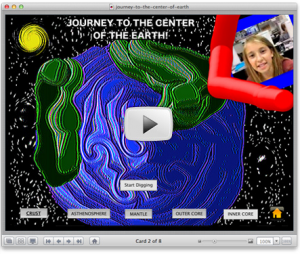Computers and I grew up at the same time, and perhaps that is why I see using technology in my teaching as a way to solve problems rather than a threat to my profession.
When I was small, computers were as big as a room and my dad let us play with the key cards. That was perfect at the time, as my world was only as big as whatever room I was in. I grew up and went to college, and by then one room could hold enough computers to support my department’s computing requirements. 
My horizons expanded beyond the college, and I was thrilled to get a ‘real’ job at an engineering firm during my senior year there. We supplied and supported CAD/CAM systems worldwide, often using email to communicate as well as other programs to publish electronic documents. Twenty-five years ago, I had no idea that my experience was unique.
Twenty years ago, I became a teacher and in some ways my problems became limited to just one room again. My students typically came in performing well below grade level, and our school received a grant to put three computers in each of the upper grades classrooms to address this problem. It took about a year for those of us using them to figure out what they could and couldn’t do for us inside the classroom. We figured out that they could be used to solve other, deeper problems, such as how to connect the classroom with the outside community.
 We weren’t “connected” like today’s wifi, but we used these computers for the students to create interactive presentations with programs such as Hyperstudio and to publish and print the class books we wrote based on interviews with community services, etc… When we realized how much of a positive impact this type of communication and connection had on families and communities, we were also able to broaden our scope as a part of the A+Schools Network and the state supported collaborative learning platform, LearnNC.org.
We weren’t “connected” like today’s wifi, but we used these computers for the students to create interactive presentations with programs such as Hyperstudio and to publish and print the class books we wrote based on interviews with community services, etc… When we realized how much of a positive impact this type of communication and connection had on families and communities, we were also able to broaden our scope as a part of the A+Schools Network and the state supported collaborative learning platform, LearnNC.org.
As we learned how to advocate and showcase the high quality of project- and arts-based learning going on in our classrooms, we used technology alongside the students to solve all kinds of problems. If we wanted to learn something, we researched with them; if we wanted to publicize something, we learned to take pictures and later create digital stories to share. If we didn’t like the way the politicians were handling something, we learned how to lobby using the computers. When we wanted to take our students out of the inner city to a remote island 200 miles away, we used computers to plan our trip as well as to create materials supporting our grant requests.
As I grew up at the same time technology grew more powerful, I don’t recall ever really worrying about learning how to use the technology, or how to incorporate it into my teaching. I did worry about helping my students learn what they needed to learn in order to be successful in whatever they chose to do in life. The varied forms of technology I’ve had access to over time simply helped me expand my ability to help students solve more complex problems.
The role of educators and education today in producing quality citizenry in this ‘knowledge economy’ is not just a complex problem, it’s a very wicked problem (Rittell and Webber, 1973; Kolko, 2012). However, I don’t believe it is the technology that is the cause of this problem. It’s how we choose to use technology.
How do you choose to use technology in your sphere of influence for something positive that you believe in?

